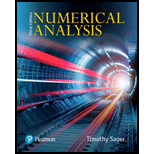
Concept explainers
Find
Want to see the full answer?
Check out a sample textbook solution
Chapter 3 Solutions
Numerical Analysis
Additional Math Textbook Solutions
Calculus Volume 3
Mathematics for the Trades: A Guided Approach (11th Edition) (What's New in Trade Math)
Discrete Mathematics and Its Applications ( 8th International Edition ) ISBN:9781260091991
Probability and Statistics for Engineers and Scientists
Pathways To Math Literacy (looseleaf)
Mathematics with Applications In the Management, Natural, and Social Sciences (12th Edition)
- Find a polynomial of degree n=2 that has the given zero(s) x = −√2, √2arrow_forwardFind three positive integers x, y, and z that satisfy the given conditions. The product is 27, and the sum is a minimum.arrow_forwardFind 3 numbers x, y, and z such that their sum is 32 and P=xy^2z is a maximum.arrow_forward
- find all the values of k such that the cubic y=kx3−(k+1)x2+(2−k)x−k has a minimum turning point of x=1 choose from the options k≥ 1/2 k≤1/2 k≤3/2 k≥3/2arrow_forwardConsider the following quadratic f(x)=x2−11x+1f(x)=x2−11x+1 with the roots αα and ββ. Suppose the new quadratic g(x)=x2+px+qg(x)=x2+px+q has the roots γ=α+βγ=α+β and δ=1α+1βδ=1α+1β. Find the coefficients pp and qq of the new quadratic correct to 2 decimal places. Select one: not in the list p= 13.00, q = 13.00 p= - 22.00, q = 121.00 p= 22.00, q = 123.00 p= 0.00, q = 121.00arrow_forwardshow the equation z^2-4ln(5z+2) = 0 has atleast one root in the interval ( 0,4)arrow_forward
- If L(x)=mx+b is the linearization of the cube root of 3x+1 at x=333 , then b=arrow_forwardwhich are the solutions for 4sinxcosx=1 over the interval [0,2pie)arrow_forwardFind the extreme values of g(x, y) = x² + y² + x²y on the circle x² + y² = 12 using the method of Lagrange multipliers.arrow_forward
 Linear Algebra: A Modern IntroductionAlgebraISBN:9781285463247Author:David PoolePublisher:Cengage Learning
Linear Algebra: A Modern IntroductionAlgebraISBN:9781285463247Author:David PoolePublisher:Cengage Learning
